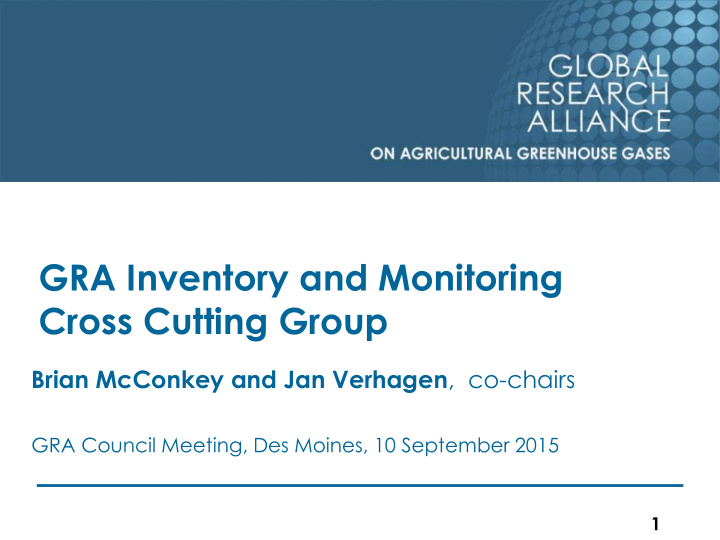



GRA Inventory and Monitoring Cross Cutting Group Brian McConkey and Jan Verhagen , co-chairs GRA Council Meeting, Des Moines, 10 September 2015 1
Inventory & Monitoring Cross-Cutting Group Co-chaired by Canada and The Netherlands Group Vision to: • Work with GRA Research Groups and partners to improve transparency, accuracy, completeness, comparability, and consistency (TACCC) of: • Inventory (Upscaled estimates of GHG; Not only UNFCCC inventory) • Monitoring (Measurement of state and trends of emissions, mitigation, and adaptation) . 2
Highlights • Meeting with the CRG July 11-12, 2015, Brasilia • Met with CRG plus separate short I&M meeting • Successful • Increased number of countries participating in the meeting (11) • Increased understanding of I&M work and interaction with the CRG 3
Highlights of Four Active Work Areas Work Area 1 To share methods and lessons learned on application of remote sensing to improve activity data. • Stocktaking of applications • Workshop opportunity • Interest in establishing a scientific network • UK is coordinating Output: • Stock take of state and opportunities of earth observation in inventory of activity data (2014-15) • Develop network or project work team(s) 4
Advantages Limitations - Real world - Resolution? - Geographic Scope - Cloud cover - Global - Data volumes - Repeatable - Complexity - Multiple modes - Cost? - Skills/Experience Solutions - Data integration - Modelling and data assimilation - Cloud computing - Free access to data (eg. Landsat, Copernicus) - Collaboration and networking – GRA! 5
Work area 2 To improve the capability to quantify mitigation strategies in inventories and to address synergies and trade-offs with adaptation strategies. • Improve knowledge sharing based on farming system similarities • Describe activity data for national inventories that enables better analysis of system-level synergies and trade-offs among gases and practices Soc. • Build on existing work • Econ. Netherlands is coordinating Environ. Outputs: • Workshop on Farming systems (February 2015) • Co-organized GRA-CCAFS side-event (Climate Smart Agriculture Science Conference, March 2015) • Opportunities: Develop network or project work team 6
Regional network on farming systems • Co-hosted by the Ministry of Agriculture and Cooperatives (MoAC) of Thailand and the GRA. • Location Bangkok • 11 – 13 February 2015 • Participants • Indonesia, Korea, Malaysia, Myanmar, Philippines, Vietnam and Thailand. • With the support from Agriterra, farmer representatives from the Philippines and Indonesia • The Netherlands, UK 7
CCAFS meeting during the CSA conference 1. Collaboration is growing. 2. Potential collaboration point is to extend models to include complex systems in developing countries. 3. Alignment is needed about protocols and measurements. There is potential to write a paper. 4. Exchange of names, no formal structures needed. 8
Work Area 3 To share knowledge and facilitate collaboration on improving national inventories Stock take of national inventory improvements under way and • planned Canada is coordinating • Output: Summary from stock take on inventory improvements • Africa Inventory Workshop sponsored by New Zealand • Opportunity: Develop network(s) to further work • 9
Inventory Stock Take Results All countries were improving aspects of both their activity data and • emission factors • Most improving across a broad range of categories and sub- categories of emissions Opportunity with GRA Number of Times Identified Networking and Collaboration 66 Networking only 18 Leaning/skill development 16 Collaboration of specific project 13 10
Work Area 4 Methodological Guidelines for Measurement of Soil Organic Carbon Stocks of Agricultural Lands • Initial focus on grassland due to opportunity to add most scientific value • Develop practical, scientific guidance to increase consistency and comparability of monitoring strategies • Canada is coordinating Outputs: modules/reports (2014-2015) on: • Post-doctoral fellow doing meta-analysis of global literature on C measurement for grasslands • Working through 270 papers (from 2000) • Meta-analysis identifying relationships needed for monitoring • Opportunity: Overall Grassland Network to further work more broadly and/or more deeply 11
I&M Challenges Active participation in Group work areas! • Involvement of practitioners in national inventory and climate • change policy advisors • Often Ministry of Environment • Most do not have the flexibility in budget or work like researchers with own project funding Engaging agricultural research scientists into the science of • inventory and monitoring 12
Ambitions Recognized massive value to the potential of work I&M Group Opportunities to add enormous value through addressing I&M issues as GRA rather than as individual counties and partners GRA is unique vehicle to achieve these opportunities We need the GRA members and partners to be more involved! 13
Goals 1. To share knowledge and facilitate collaboration on application of remote sensing to improve activity data for inventory purposes and for monitoring adaptation • Facilitate networking for exchange of knowledge and experiences. • Facilitate collaboration on projects on applications. 2. To improve the capability to quantify adaptation and mitigation options at farm level (“farming system”) • Facilitate regional and global networking. • Facilitate collaboration on projects on farming system typology. • Facilitate capability building. 14
Goals 3. To share knowledge and facilitate collaboration on improving national inventories and on the application of inventory methods to improve sustainable adaptation • Facilitate networking for exchange of knowledge and experiences. • Facilitate collaboration on projects about improvements. • Summarize experiences and approaches (i.e brief case studies) to provide information for improving inventories and linking agricultural GHG science to policy-relevant applications • Facilitate capability building. 4. To produce best practice guidance on monitoring soil organic carbon stocks over space and time • Literature review of monitoring methods and their capabilities. • Develop guidance for monitoring carbon stocks on grassland. 15
Summary • Ambitions exceed capacity • More targeted approach that is restricted to work areas with active participation has been productive • Stock taking projects have increased involvement and identified more collaborative research opportunities • Connections to UNFCCC reporting strengthened • National inventories and national communications • Inventory methods for sustainable adaptation actions • Meeting in conjunction with RG very successful 16
Recommend
More recommend